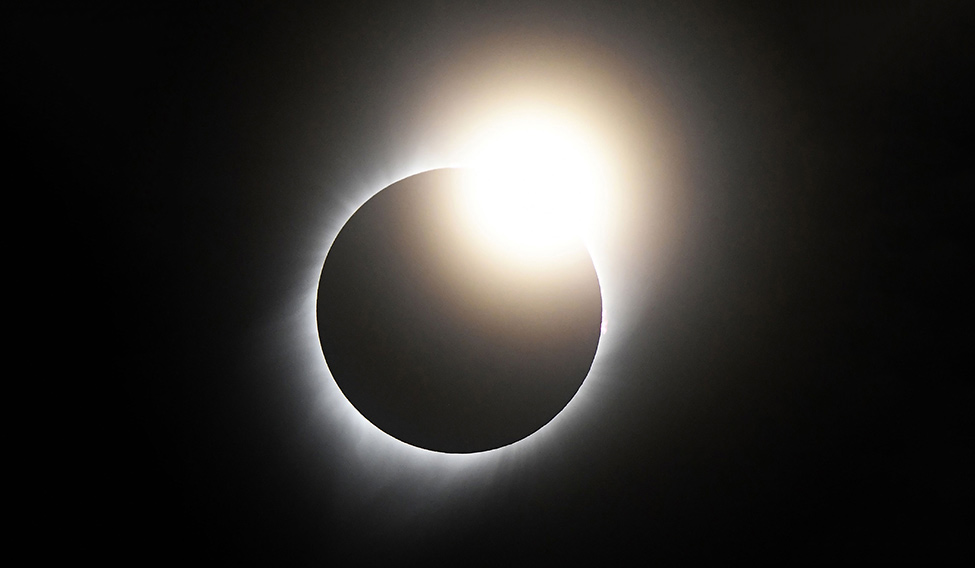Total Solar Eclipse: A Cosmic Spectacle Well Worth The Hype
Apr 7, 2024 | Pratirodh Bureau
In a solar eclipse, the moon passes in between Earth and the sun, casting its shadow on Earth. The amazing coincidence is that the moon about 400 times smaller than the sun also happens to be about 400 times closer to us than the sun, and so they appear the same size from Earth's surface (Representational Image)
Eclipse fever has gripped North America, where many people are talking, worrying and obsessing about the April 8 total solar eclipse.
The eclipse itself is beautiful and moving, and is an incredible opportunity to excite and involve the community in the scientific advances that eclipses have brought to us, and all the potential discoveries that we might see in the future, including possibly discovering life on other worlds.
In a solar eclipse, the moon passes in between the Earth and the sun, casting its shadow on Earth. The amazing coincidence is that the moon, about 400 times smaller than the sun, also happens to be about 400 times closer to us than the sun, and so they appear the same size from Earth’s surface.
When the sun, moon and Earth all line up, the shadow cast by the moon follows a narrow path that moves across the globe as the Earth rotates and the moon and Earth continue their orbital dances around the sun.
Palpable Excitement
Most of North America will have a partial eclipse on April 8. Totality will occur along the diagonal path of total shadow for a precious few minutes.
The excitement around the eclipse is palpable, coming from kids to adults, locals to visitors. Municipalities are worried: Niagara Falls predicts up to a million people visiting and Kingston predicts up to 500,000.
This is in part because of the rarity of a total solar eclipse — they happen about 375 years apart at a given location on average, and the next one anywhere in Canada isn’t for 20 years.
But the hype also stems from how beautiful a total eclipse can be. A partial eclipse is interesting. Everyone should use a solar filter or pinhole camera to safely watch the moon gradually cover the sun’s disk.
But along the narrow path where the sun-moon-Earth alignment is perfect, we’ll see a few fleeting minutes of darkness during the day, be able to see the sun’s wispy corona and see a sunrise in all directions.
Experiencing a total eclipse allows everyone to be both an astronomer, thinking about our place in the solar system, the Milky Way and the universe, and an aesthete marvelling at the beauty of the sky.
Astrological Contributions
For millennia, many societies considered eclipses as dangerous omens — a reasonable fear given how strange it is to see darkness during the day.
Predictions of when the next eclipses would occur became important for leaders. Babylonians thought the eclipse could foretell death for the king, while Mayans believed diabolical spirits would come out to attack people.
Today’s scientists may scoff at astrology, but it was this potential astrological doom that led to ancient civilizations making increasingly accurate models of how the sun, moon and planets moved.
As measurements became more accurate, the old Earth-centric solar system model was replaced by Johannes Kepler’s depiction of the sun at the focus of elliptical orbits, which led to Isaac Newton’s theory of gravity.
Careful measurements originally meant for astrology and in part because of the worry about eclipses contributed to our understanding of the universe and how it works.
Historical Spectacles
In 1842, with a total eclipse through Europe, the narrative changed and solar eclipses became tourist draws. Astronomers like British Francis Baily and George Biddell Airy travelled to see the eclipse.
But it was the vivid descriptions from writers like Austrian Adalbert Stifter that captured the world’s attention: “Never, ever in my entire life was I so shaken, from terror and sublimity so shaken, as in these two minutes — it was nothing other than if God had all at once spoken a clear word and I had understood it.”
The interest in eclipses increased for both the public and professional astronomers. It was by studying the light from the sun’s wispy corona only visible during eclipses that the element helium was discovered.
It was by looking at the bending of light from distant stars that Albert Einstein’s theory of general relativity was confirmed, bringing him to worldwide fame.
A Shared Passion
The global passion to witness and experience the eclipse is one that science educators can’t ignore. Across the continent, astronomers and teachers are educating people on how to watch safely using pinhole cameras or eclipse glasses.
Science educators explain to a fascinated audience how the sun, moon and Earth all must line up perfectly for a total eclipse to happen. We are all hoping for clear weather so we can see the corona and explain that it is somehow hotter than the surface of the sun.
Today, eclipses aren’t necessarily studied for new discoveries. However, astronomers use a similar dimming of distant stars as evidence that an exoplanet must have passed in front of it.
We’ve discovered thousands of worlds, confirming that exoplanets are common. We can now measure the slight change in light colour during an extra-solar eclipse-like transit to detect water and signs of life in an exoplanet’s atmosphere.
So the hype for the total solar eclipse on April 8 is worth it. For us, it isn’t just sublime beauty.
It is the chance to connect to huge crowds as excited as we are. It is the opportunity to link what we are seeing to the vastness of space, the millennia of history and the promise of understanding our wider universe all in three minutes in the moon’s shadow.
(The Conversation: By Robert Knobel and Kristine Spekkens, Queen’s University, Ontario)
